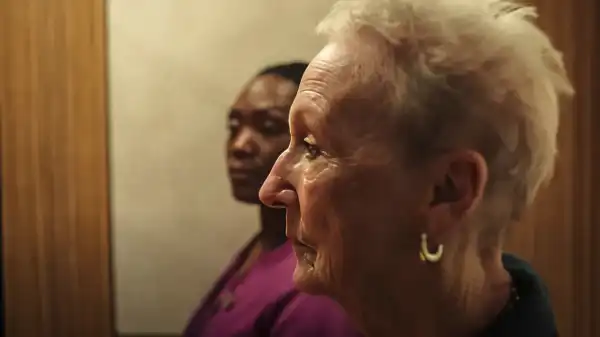
Save this storySave this storySave this storySave this story
We all have our own unique cinematic triggers, certain images that evoke a sense of disgust. I instinctively close my eyes when confronted with a character rushing to chop food, which often foreshadows a painful knife slip. In the quiet, wrenching new film The Familiar Touch, Ruth Goldman (Kathleen Chalfant), a woman in her eighties with dementia, displays a deft, measured, and safe use of a knife, chopping fresh dill for a sandwich in one scene and slicing grapefruit for a fruit salad in another. I still find myself tense, momentarily worried that writer-director Sarah Friedland is using these moments to highlight Ruth’s vulnerability, her loss of mental acuity or physical control. Fortunately, she is not. Friedland is no sadist, and Ruth is a retired cook with culinary skills that seem to defy age. Among the many rapidly fading memories, food becomes a rare and stable support.
Ruth makes these sandwiches early on for herself and her son, Steve (H. Jon Benjamin). By this point, she has forgotten his name, that he is her son, or that she even has a son. Steve’s sad, stoic expression suggests that he has grown accustomed to being treated as an outsider. This lunch is the last they will share together in Ruth’s Los Angeles home. After they finish eating, Steve drives her to Bella Vista, the upscale retirement home that, he gently reminds her, she chose some time ago. Ruth’s reaction to these (to her) unexpected events seems to conceal as much as it reveals: can we see glimpses of the woman she once was, or the woman she dreamed of becoming? Believing that Steve is asking her out, she responds with a mild obscenity that makes him uncomfortable. When he finally clears up the misunderstanding and calls her “Mom,” she not only denies being his mother but insists that she never wanted children. Dimly aware—and perhaps resentful—that she is being moved into a new house, she purses her lips, avoids eye contact, and tells Steve to go away: “I wish you wouldn’t worry,” she says with a firm determination that seems to come from deep within. We sense that here is a woman who has grown accustomed to her independence and now has it taken away.
What does Ruth know, and when does she know it? That question permeates every scene in The Familiar Touch, and lends Chalfant’s serene, fine-grained performance an unusual element of mystery. A simple expression of puzzlement takes on layers of possible meaning; a confused frown can compete with a knowing smile to a draw. As Ruth adjusts to life in Bella Vista, she can be cranky, but she quickly tempers her irritability with kindness. She’s also fairly adaptable: When certified nurse’s assistant Vanessa (a finely played Carolyn Michelle) deftly coaxes her into taking her medication, Ruth displays the warmth and playfulness that are her trademark. At times, she seems to embrace her new surroundings as an adventure, with ample room for exploration and role-playing, and she throws herself into it with a clarity that seems, for the moment, to overcome her confusion. In the film’s most charming sequence, Ruth, seeing an opportunity to be useful, wanders into the kitchen at breakfast time, dons an apron, and insists on working the shift. The workers, though surprised, graciously accept her place, with what looks like a practiced willingness. Here and elsewhere, the film becomes a portrait of everyday life in Bella Vista, as well as of Ruth herself.
Friedland emphasizes this by constantly placing Ruth in larger groups, shot in stationary long shots by cinematographer Gabe S. Elder. Sometimes it takes a while to find her, waiting at a table in the dining room or sitting with other residents during recreational activities that involve virtual reality headsets. “Familiar Touch” was filmed at Villa Gardens, a retirement community in Pasadena, and was created in close collaboration with the center’s residents and caregivers, some of whom appear as background players. (According to the film’s production notes, the residents also contributed to a variety of behind-the-scenes roles, including production design, casting, and camera work.) It’s fitting, then, that what happens onscreen between Ruth and her caregivers is an ironic spirit of collaborative improvisation, as if the characters themselves were taking part in an acting exercise. In her interactions with the home’s friendly director of health and wellbeing, a man named Brian (Andy MacQueen), Ruth mutters knowingly: “I need to play the patient and you need to play the doctor.” The giving and receiving of care is shown to be enriched on both sides by flexibility, creativity, humour and a dose of make-believe.
For all those intimate gray areas
Sourse: newyorker.com